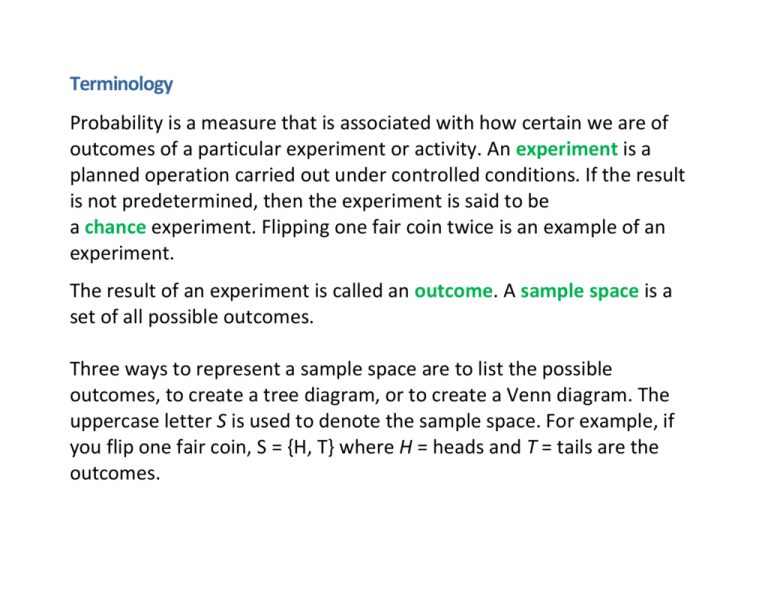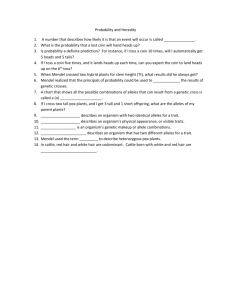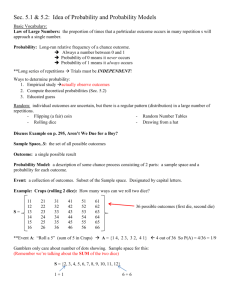Terminology
advertisement

Terminology
Probability is a measure that is associated with how certain we are of
outcomes of a particular experiment or activity. An experiment is a
planned operation carried out under controlled conditions. If the result
is not predetermined, then the experiment is said to be
a chance experiment. Flipping one fair coin twice is an example of an
experiment.
The result of an experiment is called an outcome. A sample space is a
set of all possible outcomes.
Three ways to represent a sample space are to list the possible
outcomes, to create a tree diagram, or to create a Venn diagram. The
uppercase letter S is used to denote the sample space. For example, if
you flip one fair coin, S = {H, T} where H = heads and T = tails are the
outcomes.
An event is any combination of outcomes. Upper case letters
like A and B represent events. For example, if the experiment is to flip
one fair coin, event A might be getting at most one head. The
probability of an event A is written P(A).
The probability of any outcome is the long-term relative frequency of
that outcome.
Probabilities are between 0 and 1, inclusive (includes 0 and 1 and all
numbers between these values).
P(A) = 0 means the event A can never happen.
P(A) = 1 means the event A always happens.
P(A) = 0.5 means the event A is equally likely to occur or not to occur.
For example, if you flip one fair coin repeatedly (from 20 to 2,000 to
20,000 times) the relative frequency of heads approaches 0.5 (the
probability of heads).
Equally likely means that each outcome of an experiment occurs with
equal probability.
For example, if you toss a fair, six-sided die, each face (1, 2, 3, 4, 5, or 6)
is as likely to occur as any other face.
If you toss a fair coin, a Head(H) and a Tail(T) are equally likely to occur.
If you randomly guess the answer to a true/false question on an exam,
you are equally likely to select a correct answer or an incorrect answer.
To calculate the probability of an event A when all outcomes in the
sample space are equally likely, count the number of outcomes for
event A and divide by the total number of outcomes in the sample
space.
For example, if you toss a fair dime and a fair nickel, the sample space
is {HH, TH, HT, TT} where T = tails and H = heads. The sample space has
four outcomes. A = getting one head. There are two outcomes {HT,
2
TH}. P(A) = .
4
Suppose you roll one fair six-sided die, with the numbers {1,2,3,4,5,6}
on its faces.
Let event E = rolling a number that is at least 5. There are two
outcomes {5, 6}.
2
P(E) = .
6
If you were to roll the die only a few times, you would not be surprised
if your observed results did not match the probability.
If you were to roll the die a very large number of times, you would
expect that, overall, 2/6 of the rolls would result in an outcome of "at
least 5". You would not expect exactly 2/6. The long-term relative
frequency of obtaining this result would approach the theoretical
probability of 2/6 as the number of repetitions grows larger and larger.
This important characteristic of probability experiments is the known as
the Law of Large Numbers: as the number of repetitions of an
experiment is increased, the relative frequency obtained in the
experiment tends to become closer and closer to the theoretical
probability.
Even though the outcomes don't happen according to any set pattern or
order, overall, the long-term observed relative frequency will approach
the theoretical probability. (The word empirical is often used instead of
the word observed.) The Law of Large Numbers will be discussed again
in Chapter 7.
It is important to realize that in many situations, the outcomes are not
equally likely. A coin or die may be unfair, or biased .
Two math professors in Europe had their statistics students test the Belgian 1
Euro coin and discovered that in 250 trials, a head was obtained 56% of the
time and a tail was obtained 44% of the time. The data seem to show that the
coin is not a fair coin; more repetitions would be helpful to draw a more
accurate conclusion about such bias.
Some dice may be biased. Look at the dice in a game you have at home; the
spots on each face are usually small holes carved out and then painted to make
the spots visible. Your dice may or may not be biased; it is possible that the
outcomes may be affected by the slight weight differences due to the different
numbers of holes in the faces. Gambling casinos have a lot of money depending
on outcomes from rolling dice, so casino dice are made differently to eliminate
bias. Casino dice have flat faces; the holes are completely filled with paint
having the same density as the material that the dice are made out of so that
each face is equally likely to occur.
"OR" Event:
An outcome is in the event A OR B if the outcome is in A or is in B or is in
both A and B.
For example, let A = {1, 2, 3, 4, 5} and B = {4, 5, 6, 7, 8}.
A OR B = {1, 2, 3, 4, 5, 6, 7, 8}. Notice that 4 and 5 are NOT listed twice.
"AND" Event:
An outcome is in the event A AND B if the outcome is in both A and B at
the same time.
For example, let A and B be {1, 2, 3, 4, 5} and {4, 5, 6, 7, 8}, respectively.
Then A AND B = {4,5}.
The complement of event A is denoted A' (read "A prime"). A' consists
of all outcomes that are NOT in A. Notice that P(A) + P(A') = 1. For
example, let S = {1, 2, 3, 4, 5, 6} and let A = {1, 2, 3, 4}. Then, A' = {5, 6}.
4
2
4
2
P(A) = , P(A') = , and P(A) + P(A') = + = 1
6
6
6
6
The conditional probability of A given B is written P(A|B).
P(A|B) is the probability that event A will occur given that the
event B has already occurred. A conditional reduces the sample space.
We calculate the probability of A from the reduced sample space B. The
formula to calculate P(A|B) is
P (𝐴 | 𝐵 ) =
P(𝐴 and 𝐵)
P(𝐵)
where P(B) is greater than 0.
For example, suppose we toss one fair, six-sided die. The sample
space S = {1, 2, 3, 4, 5, 6}. Let A = face is 2 or 3 and B = face is even (2, 4,
6).
To calculate P(A|B), we count the number of outcomes 2 or 3 in the
sample space B = {2, 4, 6}. Then we divide that by the number of
outcomes in B (and not S).
We get the same result by using the formula. Remember that S has 6
outcomes.
𝐏(𝑨 𝐚𝐧𝐝 𝑩)
𝐏(𝑨|𝑩) =
𝐏(𝑩)
(𝐭𝐡𝐞 𝐧𝐮𝐦𝐛𝐞𝐫 𝐨𝐟 𝐨𝐮𝐭𝐜𝐨𝐦𝐞𝐬 𝐭𝐡𝐚𝐭 𝐚𝐫𝐞 𝟐 𝐨𝐫 𝟑 𝐚𝐧𝐝 𝐞𝐯𝐞𝐧 𝐢𝐧 𝐒)/𝟔
=
(𝐭𝐡𝐞 𝐧𝐮𝐦𝐛𝐞𝐫 𝐨𝐟 𝐨𝐮𝐭𝐜𝐨𝐦𝐞𝐬 𝐭𝐡𝐚𝐭 𝐚𝐫𝐞 𝐞𝐯𝐞𝐧 𝐢𝐧 𝐒)/𝟔
𝟏/𝟔 𝟏
=
=
𝟑/𝟔 𝟑
Understanding Terminology and Symbols
It is important to read each problem carefully to think about and
understand what the events are. Understanding the wording is the first
very important step in solving probability problems. Reread the problem
several times if necessary. Clearly identify the event of interest.
Determine whether there is a condition stated in the wording that
would indicate that the probability is conditional; carefully identify the
condition, if any.
EXERCISE 1
In a particular college class, there are male and female students. Some
students have long hair and some students have short hair. Write
the symbols for the probabilities of the events for parts (a) through (j)
below. (Note that you can't find numerical answers here. You were not
given enough information to find any probability values yet;
concentrate on understanding the symbols.)
Let F be the event that a student is female.
Let M be the event that a student is male.
Let S be the event that a student has short hair.
Let L be the event that a student has long hair.
a. The probability that a student does not have long hair.
b. The probability that a student is male or has short hair.
c. The probability that a student is a female and has long hair.
d. The probability that a student is male, given that the student has long
hair.
e. The probability that a student has long hair, given that the student is
male.
f. Of all the female students, the probability that a student has short
hair.
g. Of all students with long hair, the probability that a student is female.
h. The probability that a student is female or has long hair.
i. The probability that a randomly selected student is a male student
with short hair.
j. The probability that a student is female.
SOLUTION
a. P(L')=P(S)
b. P(M or S)
c. P(F and L)
d. P(M|L)
e. P(L|M)
f. P(S|F)
g. P(F|L)
h. P(F or L)
i. P(M and S)
j. P(F)







